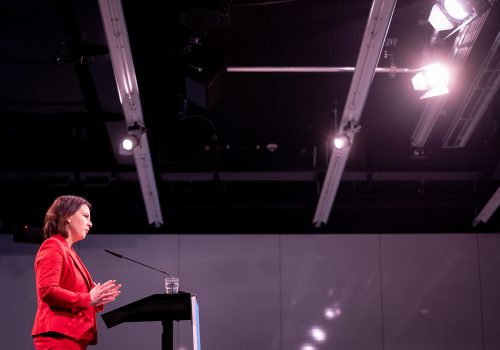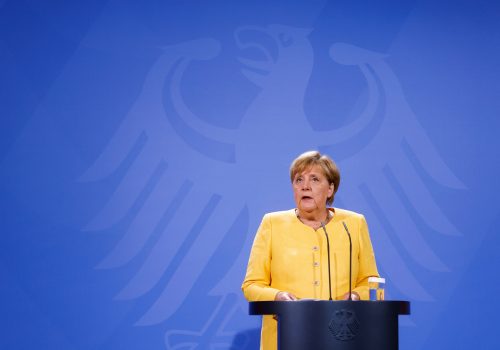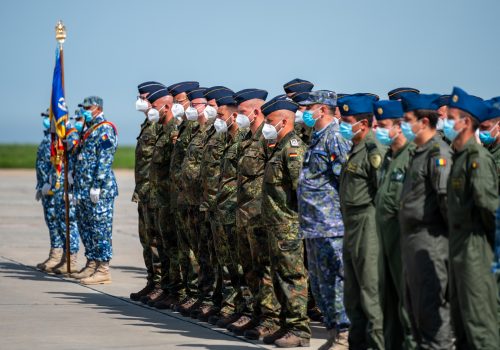Coalition crazy: Here’s how Germany’s new government could shake out
As Germany’s 60 million voters head to the ballot box for Sunday’s federal elections, the race to replace Chancellor Angela Merkel seems more open-ended than most had expected even a few months ago. In a campaign that’s seen the fortunes of major parties and their Spitzenkandidaten, or lead candidates, go through several surprising reversals over the last few months, polls now suggest a narrowing race between the center-left Social Democratic Party (SPD), led by Olaf Scholz, and Armin Laschet’s center-right Christian Democratic Union (CDU).
The only safe prediction is this: For the first time since the 1950s, the German government will likely require a three-way coalition. That could send Europe’s largest economy into messy, months-long coalition negotiations that could last into early 2022. The result could be a Germany led by a caretaker government under perennial Chancellor Angela Merkel for several months more—and lacking political clout at a time when major initiatives at the EU level come to a head and the transatlantic partnership stumbles from one crisis to the next.
On the eve of this major vote, we’re offering an authoritative guide to the players and parties involved—as well as gaming out the various scenarios facing Germany’s coalition-builders.
Click on the links below to jump to a section:
What to watch on election night…
…and in the days and weeks to follow
The key players
A drawn-out CDU leadership contest eventually won by Armin Laschet, the premier of Germany’s most populous state, North Rhine-Westphalia, and the open fight with its Bavarian sister party, the Christian Social Union (CSU), over the nomination for their joint chancellor candidate has seen the CDU-CSU alliance drop 10-15 percent in the polls since early 2021. With an uncharismatic Laschet at the helm—and following his missteps after flash floods in his state this summer, lackluster campaigning, and the lack of a clear platform—the CDU has lingered around 20 percent. Amid a more concerted campaign effort and more appearances from Merkel, who until the last few weeks had refrained from campaigning, the CDU has shown signs of a small surge only in recent days up to 23 percent.
The Green Party, a product of the 1970s environmental and peace movements that has since gained extensive, state-level government experience and nationally as part of a 1998-2005 SPD-led coalition, peaked at around 28 percent last spring, having carefully expanded its platform to more centrist voters. However, following intense—and, some would argue, overblown—media scrutiny of Annalena Baerbock, the Greens’ first ever-chancellor candidate, for allegations of plagiarism, delayed bonus disclosures, and botched campaign appearances, the party has dropped to around 16-18 percent. The Greens seem to have been unable to capitalize on the government’s failures during the Afghanistan withdrawal or dire news on the climate, the party’s core issue. Nor have Baerbock and her party been able to inspire new momentum among Germany’s aging and famously status-quo electorate with a message of change.
Perhaps the most stunning reversal has seen the Social Democrats rise to the lead of the pack during the last eight weeks of campaigning. Years of infighting among centrists and progressives over the party’s strategic direction and its junior role in three grand coalitions with the CDU threatened to plunge this grand old dame of German party politics into insignificance. With the party hovering around 15-17 percent as late as July, Spitzenkandidat Olaf Scholz has since taken the SPD to around 25 percent and the lead in the polls. Many credit the weak competition in Laschet and Baerbock for the surprising success of the uncharismatic former mayor of Hamburg and current finance minister. Others argue it’s all about his strategy to present himself as the candidate of Merkellian continuity and status-quo politics in style and substance.
The free-market, libertarian Free Democrats (FDP) have settled in at around 11 percent. If the party maintains that result, it could become somewhat of a kingmaker in subsequent coalition talks. FDP leader Christian Lindner unilaterally withdrew from talks with the CDU and Greens in 2017, and has since tried to spin that decision as proof that his party will be ready to do so again. But the 2017 FDP-provoked collapse of “Jamaica” coalition talks has left a mark on him and his party. Potential partners might conclude that the legacy of that decision now works to his detriment—forcing Linder to make concessions, knowing he cannot walk away again and take the blame for yet another collapse of talks (especially if these have dragged on for months).
The two fringe parties on the right and left have not played any significant role compared to previous federal elections. The right-wing populist Alternative for Germany (AfD) has remained steady at around 11 percent and has struggled during the pandemic to energize its base and attract new voters with its focus on migration and law and order. Meanwhile, the socialist Left Party is polling just above the 5-percent threshold for proportional seats in the Bundestag—having featured as a prop for the SPD and Greens, which can dangle before the CDU and FDP the remote possibility of creating a coalition with The Left.
While Germans don’t vote for chancellor directly, pollsters have long asked who they’d prefer at the helm of the next government if they could vote for a candidate. On the eve of the election, there seems to be limited excitement about any of the three Spitzenkandidaten. Scholz leads with 40 percent over Laschet’s 19 percent, with the Greens’ Annalena Baerbock at 13 percent, and 28 percent of respondents saying they don’t know or prefer none of the above. When asked about the next coalition government, 34 percent prefer an SPD-led government over 29 percent who support the CDU in the driver’s seat. Only 12 percent want a Green-led coalition.
Color-coding coalitions
Germany’s complex election system may also impact the distribution of seats in the next Bundestag and could be of major importance in a particularly tight race. The basic size of 598 seats in the Bundestag—half chosen by direct candidates in 299 constituencies, and the other half based on the proportional votes won by party lists—is adjusted by so-called overhang and balancing mandates (or seats). These can increase the final size of the Bundestag by dozens of seats.
There is little historic precedent for building a three-way coalition, and if current polls hold, both the SPD and the CDU could separately invite other parties to pre-negotiations in the weeks immediately following the elections, making for five to six coalition scenarios.
Most of these three-way combinations break down into two camps along economic- and social-policy lines, one with a center-right orientation of CDU and FDP, the other with a center-left majority of SPD and Greens. None are tested at the federal level, though several have survived in various German states. Even when one trio wraps up negotiations, the outcome will likely have to be put to a vote by one or more party bases. The process could be long and painful.
In Germany’s multi-party system, political chromatics go far beyond the United States’ red and blue. Coalition constellations are usually designated by nicknames, abbreviations, or national flags corresponding to the colors assigned to German parties.
Here’s a breakdown of the various scenarios and their possible implications, starting with the two most likely outcomes. (Note: All projections assume 598 seats and no overhang or balancing mandates, based on this data.)
The ‘traffic light’ coalition: Stop on…yellow?
Coalition partners: SPD (red), FDP (yellow), Greens (green)
Center of gravity: Left of center, given two progressive parties in the SPD and the Greens
Dynamics: The SPD and Greens have made clear in recent weeks that governing with one another would be their preferred choice. The FDP has been openly skeptical toward this coalition option, but its leadership has not ruled out the possibility completely. It might not have many other good options to govern (depending on the CDU’s performance), even if the “traffic light” is highly unpopular among its base. The Greens may need to make the most concessions to keep on board the FDP as the political odd man out, although the fallout from the FDP’s 2017 decision to walk away from coalition talks at the last minute may change that dynamic.
Majority: The coalition would have a healthy majority of around 40 seats.
Stumbling blocks: The FDP and Greens are likely to clash on tax reform, a range of climate-related issues—from energy and CO2 price mechanisms to technology-versus-regulatory approaches—and fiscal policies, such as the debt break and the eurozone. Even if they find compromise in negotiations, both might be locked into a continuous fight in government.
The view from Brussels and Washington: The SPD and Greens will likely push for laxer debt rules and both support turning the NextGenerationEU fund into a more permanent mechanism. On EU trade policy, German leadership will subside under SPD-Green influence, and the FDP is unlikely to pick this as its battle. All three will remain broadly supportive of strong transatlantic partnership in rhetoric. On substance, the SPD’s soft stance and the pro-business FDP’s occasional wavering on Russia—as well as SPD and Green questions over nuclear-sharing within NATO—may raise concerns in Washington. That said, all three parties’ platforms suggest more hawkish stances on China.
The ‘Jamaica’ coalition: Second time’s a charm?
Coalition partners: CDU (black), Greens (green), FDP (yellow)
Center of gravity: Right of center, given a CDU-FDP majority
Dynamics: With a strong showing—and as the odd man out that needs to be kept on board—the Greens could be able to extract even more concessions from their potential partners than in a “traffic light” coalition. As any self-respecting conservative party in Europe, the CDU’s will to continue governing may override its many differences with the Greens. But a weakened CDU leader may also come under pressure from his own conservative wing after a poor election result to avoid making too many concessions to the Greens. Statedly its preferred choice, the FDP will have much overlap with the CDU and will face considerable political pressure not to walk away from the same scenario as in 2017, especially in the later stages of coalition talks. In recent days, toth the FDP and CDU have started wooing the Greens.
Majority: The coalition would have a slimmer majority of around 20-25 seats.
Stumbling blocks: The Greens will clash with both the CDU and FDP over economic, climate, fiscal, and social policies.
The view from Brussels and Washington: Brussels will likely see more of the same as in the Merkel years. Except on climate policies, the Greens are unlikely to push through major EU-level initiatives or reforms against the weight of two status-quo partners. For Washington, a “Jamaica” coalition could be the best of both worlds—with the Greens bringing a welcome hawkish stance on Russia and China, while their critical stances on defense spending will likely be overridden by the CDU and FDP.
The following are possible, but less likely, options:
R2G: A socialist utopia?
Coalition partners: SPD (red), Greens (green), The Left (dark red), or red-red-green.
Center of gravity: Significantly left of center, given three progressive parties
Dynamics and likelihood: The mainstream democratic parties have a non-cooperation policy toward The Left at the federal level (similar to the exclusion policy against the AfD on the right). But so far, the SPD and the Greens have refused to explicitly rule out the R2G option this time around, likely as a means to keep the pressure on both the conservatives and the FDP. The latter have noticed and are trying to mobilize centrist voters and their own bases with the specter of government participation by the far left. But what might work for all four, based on different campaign purposes, seems a highly unlikely option for governing. The Left’s categorical opposition to NATO and fundamental critique of the EU in its current form create fundamental differences with the SPD and Greens, and would call into question Germany’s Western integration. And even on economic policy, The Left hardly speaks the same language as the other two.
The ‘Kenya’ coalition: A supersized grand coalition
Coalition partners: SPD (red), CDU (black), Greens (green)
Center of gravity: Left-leaning, given two progressive parties
Dynamics and likelihood: The Kenya option would require the CDU to accept a junior role under the Social Democrats and a minority role among a progressive majority, which might prove difficult after a major election defeat. The CDU would most likely prefer to rejuvenate itself in opposition. Programmatically, the alliance could work among the three partners, but would mean more status-quo politics on major policy areas.
The ‘Germany’ coalition: The SPD’s worst nightmare?
Coalition partners: CDU (black), SPD (red), and the FDP (yellow)
Center of gravity: Center-right-leaning
Dynamics and likelihood: A “Germany” coalition might work on paper and would have the second largest majority projected. But having been dragged into the current coalition with the CDU kicking and screaming after all other coalition talks failed, progressives in the SPD are highly unlikely to acquiesce to what would amount to Kenya-in-reverse. For the Social Democrats, such a coalition would mean an expanded grand coalition with a hefty center-right majority and two difficult partners instead of only one.
What to watch on election night…
When the first reliable projections come in Sunday night, all eyes will be on the differential between the SPD and the CDU. That difference has tightened in the latest pre-election polls. Anything that brings Laschet and his CDU within 1-2 percent of Scholz’s SDP will allow the former to lay claim to leading a government and create more coalition contingencies. If the SPD retains a 4-plus percent lead over the CDU, there seems to be a more limited mandate for the CDU to make such claims confidently.
The CDU’s result will likely not only determine Laschet’s political future in national politics, but also decide whether any center-right coalition options are strong options. A weak showing at around 20 percent will make a “Jamaica” coalition with the Greens and Liberals a less reliable option and could slightly change the overall dynamics of coalition scenarios and talks.
Anyone hoping for changes in Germany’s posture on its foreign, climate, or eurozone policies will be closely watching the Greens, whose final results traditionally tend to underperform their pre-election poll numbers. Baerbock’s party has been most critical of the grand coalition’s stances on Russia and the Nord Stream 2 natural gas pipeline, as well as on China and its human rights record, and has called for looser fiscal rules in the eurozone and greater German leadership in the European Union. With Germany a major player in EU economic and fiscal policy, Green positions on linking trade deals more closely to social and environmental standards may also impact the European trade policy agenda. If the Greens end up closer to 20 percent, rather than 15, they will have a stronger voice in any coalition scenario.
…and in the days and weeks to follow
Both the SPD and the Greens may have their biggest challenges yet to come in coalition talks.
Remarkably, given the Green Party’s history of intense internal debate (and even strife), Baerbock and her co-leader Robert Habeck have maintained the truce they’d carefully constructed among the left-wing and more centrist wings of the party in recent years. In the past, that clash, and the demands of the left, often threatened to undercut the Greens’ viability as a governing party, especially in the eyes of more mainstream voters. The unity and discipline among adherents of both camps during the campaign is unusual. A weaker-than-expected result may embolden both to return to more open sparring, while a strong showing will empower the co-leaders and their ability to navigate conflicting internal demands.
The SPD seems in a similar, if perhaps more challenging, situation. Scholz’s success in leading the SPD to 25 percent in polls has forced even the most outspoken leftist party voices into line—or in some cases, into hiding. Scholz’s centrist course in the campaign has yet to create any backlash from a traditionally cantankerous party and the progressive wing that seemed to have won the decade-long internal war in the SPD following their victory in the 2019 leadership contest. But whether that discipline will hold in intense coalition talks, especially with the pro-business FDP, remains to be seen. If Scholz can point to three centrist SPD successes on Sunday—his own, plus that of two centrist candidates in the concurrent state elections in Berlin and Mecklenburg-Western Pomerania, which both look likely—that will strengthen his hand vis-à-vis internal challenges and rebellions.
Jörn Fleck is deputy director of the Atlantic Council’s Europe Center.
Further reading
Image: Election posters of Germany's top candidates for chancellor, Armin Laschet, North Rhine-Westphalia's State Premier and Christian Democratic Union (CDU) leader, Olaf Scholz, German Minister of Finance of the Social Democratic Party (SPD), Annalena Baerbock, co-leader of Germany's Green party, and Christian Lindner, leader of the Free Democratic Party of Germany (FDP) are pictured, in Berlin, Germany, on September 16, 2021. Photo by Fabrizio Bensch/Reuters.


